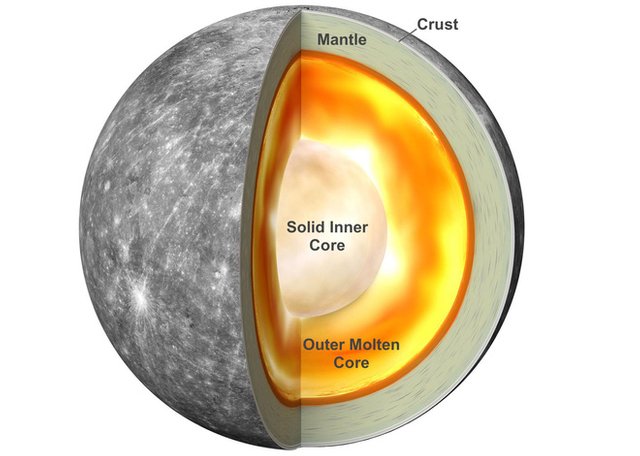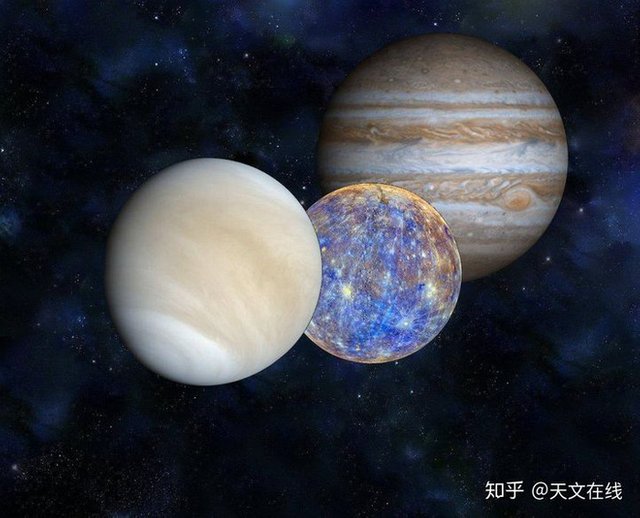Why does Mercury have a huge iron core, accounting for about 42% of its volume, while Earth is only 17%?
Now, the latest research from the University of Maryland, USA shows a correlation between the sun's magnetic field and the planet's interior, which could reveal the mystery of the existence of a giant iron core. giant in Mercury.
This study disproves the previous spectral hypothesis of Mercury. For decades, scientists have believed that during the formation of the solar system,collisions between Mercury and other celestial bodies blew away much of the planet's crust and caused the metal core to fall. Its interior has become massive and dense, but the latest research suggests that the collision was not the culprit, instead, it was the sun's magnetic field that caused the planet's core to become so large. an unusually way.
 .
.
The latest research shows that after the formation of planets in the solar system, the solar magnetic field gradually attracts the prefix to the central region of the solar system, which explains why Mercury, the planet. The closest planet to the sun, has a larger core than other computers, and the mass and safety on the action computer are much better than that of the outer layers of planets like Earth and Mars.
William McDonald, a professor of geology at the University of Maryland, and Takashi Yoshizaki at Tohoku University in Japan have established a model for how the density, mass, and iron content of the planet's core is affected by distance from the planet. field of the face.
McDonald said: "The four planets in the same solar system - Mercury, Venus, Earth and Mars, are made of metal and rock in different proportions. As the planets move further and further away from the Sun. In the sun, the metal content in their cores will also decrease.By showing that the distribution of early matter during the early formation of the solar system was controlled by the magnetic field help of them, I explain how this process came about".
.jpg)
McDonald's previously developed the Earth composition model, which is a popular model used by planetary scientists to determine the composition of planets. His latest model shows that during the early solar system's formation, the young sun was surrounded by clouds of dust and gas, and iron particles were sucked into the central region of the solar system by the solar magnetic field. God. When planets in the solar system are born from these swirling clouds of dust and gas, the cores of planets near the sun will absorb more iron than planets far from the sun.
Researchers have found that the density and proportion of iron in the cores of rocky planets is related to the strength of the magnetic field around the sun during the formation of the planets.
The composition of the planet's inner core is critical to its ability to sustain life. For example, Earth's molten iron core would form the magnetosphere to protect Earth from cancer-causing cosmic rays. The Earth's core contains most of the phosphorus on our planet - an important nutrient for sustaining carbon-based life.
Using existing planet-forming models, McDonald determined the rate at which gas and dust were sucked into the center of the solar system during solar system formation. He took into account the magnetic field created during the formation of the sun and calculated how the magnetic field pulled iron through clouds of dust and gas.
As the solar system began to cool in its early days, dust and gas that had not been drawn into the center of the solar system began to gather together. The dust gas closer to the sun is exposed to a stronger magnetic field, and therefore contains more iron than the dust gas farther from the sun. As these dusty gases merge and cool to form planets, they begin to rotate, and gravity pulls iron into their cores.

When McDonald incorporated this model into his calculations of planet formation, it revealed gradients in metal content and density, which are in perfect agreement with scientists' understanding of planets in the solar system. Sun. Mercury's metal core makes up about three-quarters of the mass, the cores of Earth and Venus are only one-third the mass, and the core of Mars is only one-quarter of the mass.
The latest understandings of the role of magnetism in the formation of planets have made it difficult to discover and study planets outside the solar system because so far scientists have not been able to find a way. How to observe the magnetism of stars from the Earth's point of view - Scientists deduce the make-up of an outer planet based on the spectrum of solar radiation. Different elements in a star will emit radiation at different wavelengths, so by measuring these wavelengths we can know the composition of the star and the planets around it.
The next step in this work is to allow scientists to find another planetary system similar to the solar system - a planetary system consisting of rocky planets farther from the star. If the densities of these exoplanets decrease as they radiate outward from the sun, as in our own solar system, the researchers can confirm this new theory and infer that the magnetic fields of the stars influence planet formation.
Story Source:
Materials provided by University of Maryland. Note: Content may be edited for style and length.
Another thing to consider is that our sun is of a magnitude that iron is the heaviest element it can create. All incidences of gold and other heavy elements can only be produced naturally in stars with supernova events.